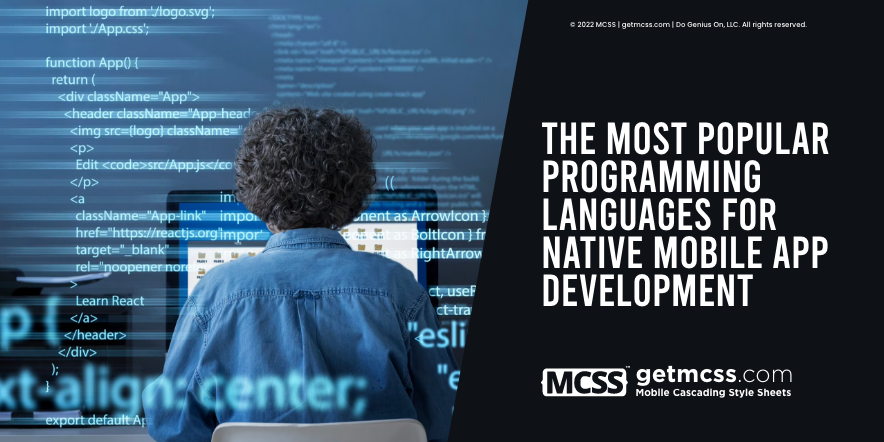In the world of native mobile app development, choosing the right programming language is crucial. With an ever-growing list of languages, it can be daunting to decide which one to use for your next project. In this article, we will explore the most popular programming languages for native mobile app development, discussing their pros and cons, and how they can be used in conjunction with the MCSS framework.
Swift for iOS Development
Swift is a modern programming language created by Apple for iOS, macOS, watchOS, and tvOS app development. Swift was introduced in 2014 as a successor to Objective-C, offering improved performance and safety features.
Pros
-
Fast and efficient: Swift is designed for performance, making it an excellent choice for complex and resource-intensive apps.
-
Safety: Swift has built-in safety features, reducing the likelihood of crashes and making it easier to debug.
-
Ease of use: Swift is known for its clean and easy-to-read syntax, making it beginner-friendly.
-
Active community: Swift has a large and active community, providing developers with numerous resources and support.
Cons
-
Limited to Apple platforms: Swift is designed specifically for Apple platforms, meaning it cannot be used for Android app development.
-
Still evolving: Swift is a relatively new language, and although it has matured significantly, some developers may prefer more established options.
By using the MCSS framework in conjunction with Swift, developers can create visually stunning iOS apps with ease, while also benefiting from the performance and safety features offered by Swift.
Kotlin for Android Development
Kotlin is a modern programming language developed by JetBrains that runs on the Java Virtual Machine (JVM). Google announced Kotlin as an official language for Android app development in 2017, positioning it as an alternative to Java.
Pros
-
Interoperability with Java: Kotlin is fully interoperable with Java, allowing developers to use existing Java libraries and frameworks.
-
Concise and expressive: Kotlin's syntax is more concise than Java's, making it easier to read and write.
-
Safety features: Kotlin includes null safety and immutability features, reducing the likelihood of crashes and bugs.
-
Support from Google: Kotlin has been officially endorsed by Google, ensuring its ongoing development and support.
Cons
-
Smaller community: Kotlin's community is smaller than Java's, which may result in fewer resources and support.
-
Slower compilation times: Kotlin's compilation times can be slower than Java's, especially for larger projects.
Integrating the MCSS framework with Kotlin allows developers to create visually consistent Android apps while leveraging Kotlin's modern features and interoperability with Java.
Objective-C for iOS Development
Objective-C is an object-oriented programming language that has been used for Apple platform development since the 1980s. Although Swift has largely supplanted Objective-C for new projects, there are still many existing apps written in Objective-C.
Pros
-
Mature and stable: Objective-C is a well-established language with a long history of use in Apple platform development.
-
Extensive libraries and frameworks: Objective-C developers have access to a wealth of libraries and frameworks built up over the years.
Cons
-
Verbose syntax: Objective-C's syntax can be difficult to read and write compared to modern languages like Swift and Kotlin.
-
Declining popularity: With the rise of Swift, Objective-C's popularity and support are waning.
Java for Android Development
Java is a widely used programming language that has been the backbone of Android app development since its inception. Although Kotlin has gained popularity in recent years, Java remains a strong choice for Android development.
Pros
-
Mature and well-established: Java is a popular and well-established language, with a large community and a wealth of resources.
-
Extensive libraries and frameworks: Java has a vast ecosystem of libraries and frameworks, making it easier to find solutions for a wide range of development challenges.
-
Platform independence: Java code can be easily ported to other platforms, increasing its versatility.
Cons
-
Verbose syntax: Java's syntax can be more verbose compared to Kotlin, which may lead to longer development times.
-
Slower performance: Java's performance can be slower than Kotlin's, particularly in resource-intensive apps.
Integrating the MCSS framework with Java can help developers create visually appealing Android apps while taking advantage of Java's mature ecosystem and platform independence.
Conclusion
Choosing the right programming language for native mobile app development depends on various factors, such as platform, developer experience, and project requirements. Swift and Kotlin have emerged as popular choices for iOS and Android development, respectively, due to their modern features and performance advantages. However, Objective-C and Java remain viable options, particularly for maintaining existing apps or leveraging their extensive libraries and frameworks.
The MCSS framework can be integrated with any of these programming languages, enabling developers to create visually consistent and aesthetically pleasing apps across platforms. By understanding the pros and cons of each language and considering your project's specific needs, you can make an informed decision and create a successful native mobile app.
References
The Case for Java in Banking Applications and the Alternatives. (2023, March 15). Medium. Retrieved May 3, 2023, from https://medium.com/@lanceharvieruntime/the-case-for-java-in-banking-applications-and-the-alternatives-7bc74c0b81e
هاي سورس |High Source What is the kotlin programming language and the advantages of working with it. (2023, April 2). هاي سورس |High Source. Retrieved May 3, 2023, from https://highsource.sa/en/blogs/87/

